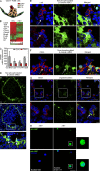Hematopoietic stem cell development requires transient Wnt/β-catenin activity
- PMID: 22802352
- PMCID: PMC3409499
- DOI: 10.1084/jem.20120225
Hematopoietic stem cell development requires transient Wnt/β-catenin activity
Abstract
Understanding how hematopoietic stem cells (HSCs) are generated and the signals that control this process is a crucial issue for regenerative medicine applications that require in vitro production of HSC. HSCs emerge during embryonic life from an endothelial-like cell population that resides in the aorta-gonad-mesonephros (AGM) region. We show here that β-catenin is nuclear and active in few endothelial nonhematopoietic cells closely associated with the emerging hematopoietic clusters of the embryonic aorta during mouse development. Importantly, Wnt/β-catenin activity is transiently required in the AGM to generate long-term HSCs and to produce hematopoietic cells in vitro from AGM endothelial precursors. Genetic deletion of β-catenin from the embryonic endothelium stage (using VE-cadherin-Cre recombinase), but not from embryonic hematopoietic cells (using Vav1-Cre), precludes progression of mutant cells toward the hematopoietic lineage; however, these mutant cells still contribute to the adult endothelium. Together, those findings indicate that Wnt/β-catenin activity is needed for the emergence but not the maintenance of HSCs in mouse embryos.
Figures






Similar articles
-
Identification of 2 novel genes developmentally regulated in the mouse aorta-gonad-mesonephros region.Blood. 2003 Mar 15;101(6):2246-9. doi: 10.1182/blood-2002-07-2260. Epub 2002 Nov 14. Blood. 2003. PMID: 12433684
-
Endothelium and NOTCH specify and amplify aorta-gonad-mesonephros-derived hematopoietic stem cells.J Clin Invest. 2015 May;125(5):2032-45. doi: 10.1172/JCI80137. Epub 2015 Apr 13. J Clin Invest. 2015. PMID: 25866967 Free PMC article.
-
NR4A1 and NR4A2 orphan nuclear receptors regulate endothelial-to-hematopoietic transition in mouse hematopoietic stem cell specification.Development. 2024 Nov 15;151(22):dev201957. doi: 10.1242/dev.201957. Epub 2024 Nov 26. Development. 2024. PMID: 39589268 Free PMC article.
-
[Current status of study on embryonic hematopoietic development in aorta-gonad-mesonephros -- review].Zhongguo Shi Yan Xue Ye Xue Za Zhi. 2009 Feb;17(1):243-6. Zhongguo Shi Yan Xue Ye Xue Za Zhi. 2009. PMID: 19236789 Review. Chinese.
-
Role of the microenvironment of the embryonic aorta-gonad-mesonephros region in hematopoiesis.Ann N Y Acad Sci. 2001 Jun;938:109-16. doi: 10.1111/j.1749-6632.2001.tb03579.x. Ann N Y Acad Sci. 2001. PMID: 11458497 Review.
Cited by
-
Emergence of hematopoietic stem and progenitor cells involves a Chd1-dependent increase in total nascent transcription.Proc Natl Acad Sci U S A. 2015 Apr 7;112(14):E1734-43. doi: 10.1073/pnas.1424850112. Epub 2015 Mar 23. Proc Natl Acad Sci U S A. 2015. PMID: 25831528 Free PMC article.
-
Alox5 Blockade Eradicates JAK2V617F-Induced Polycythemia Vera in Mice.Cancer Res. 2017 Jan 1;77(1):164-174. doi: 10.1158/0008-5472.CAN-15-2933. Epub 2016 Oct 26. Cancer Res. 2017. PMID: 27784744 Free PMC article.
-
Multispecies RNA tomography reveals regulators of hematopoietic stem cell birth in the embryonic aorta.Blood. 2020 Aug 13;136(7):831-844. doi: 10.1182/blood.2019004446. Blood. 2020. PMID: 32457985 Free PMC article.
-
Wnt9a Is Required for the Aortic Amplification of Nascent Hematopoietic Stem Cells.Cell Rep. 2016 Nov 1;17(6):1595-1606. doi: 10.1016/j.celrep.2016.10.027. Cell Rep. 2016. PMID: 27806298 Free PMC article.
-
β-catenin and γ-catenin are dispensable for T lymphocytes and AML leukemic stem cells.Elife. 2020 Aug 21;9:e55360. doi: 10.7554/eLife.55360. Elife. 2020. PMID: 32820720 Free PMC article.
References
-
- Brault V., Moore R., Kutsch S., Ishibashi M., Rowitch D.H., McMahon A.P., Sommer L., Boussadia O., Kemler R. 2001. Inactivation of the beta-catenin gene by Wnt1-Cre-mediated deletion results in dramatic brain malformation and failure of craniofacial development. Development. 128:1253–1264 - PubMed
-
- Cattelino A., Liebner S., Gallini R., Zanetti A., Balconi G., Corsi A., Bianco P., Wolburg H., Moore R., Oreda B., et al. 2003. The conditional inactivation of the β-catenin gene in endothelial cells causes a defective vascular pattern and increased vascular fragility. J. Cell Biol. 162:1111–1122 10.1083/jcb.200212157 - DOI - PMC - PubMed
Publication types
MeSH terms
Substances
Grants and funding
LinkOut - more resources
Full Text Sources
Other Literature Sources
Medical
Molecular Biology Databases
Miscellaneous

